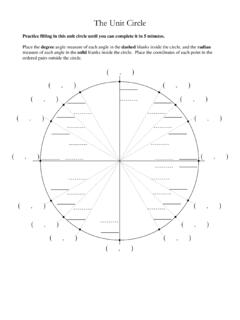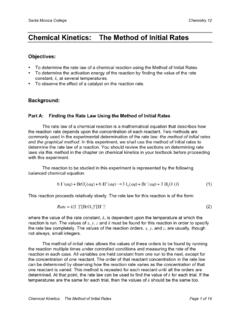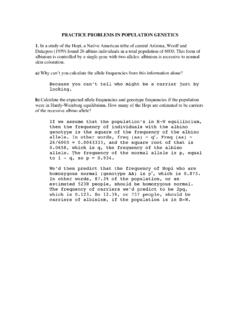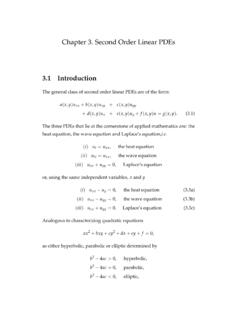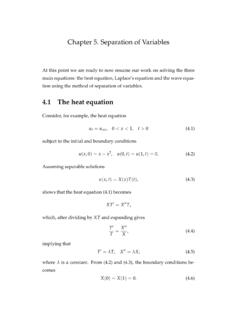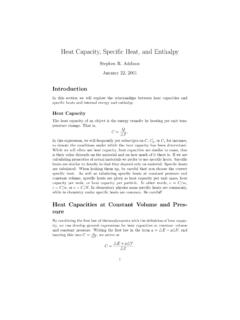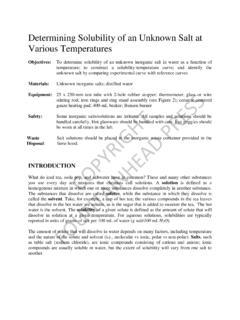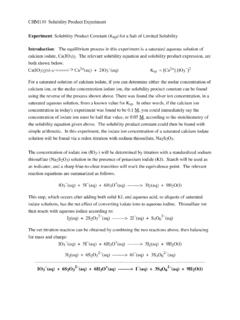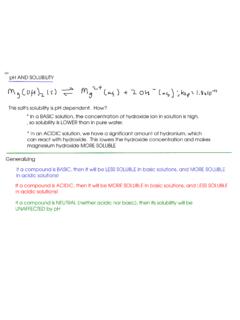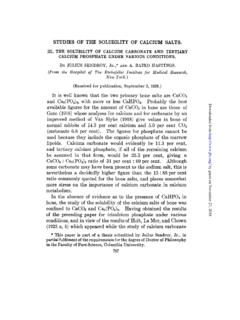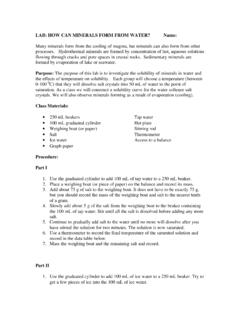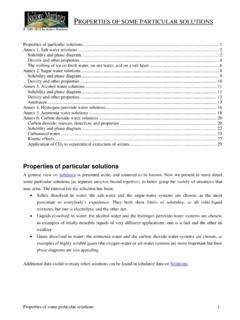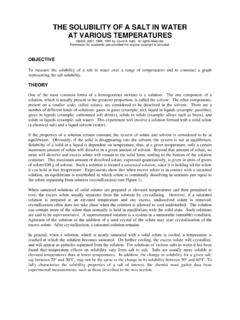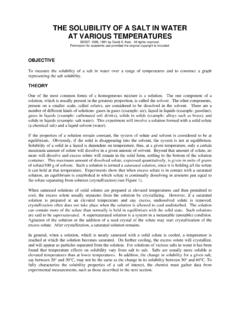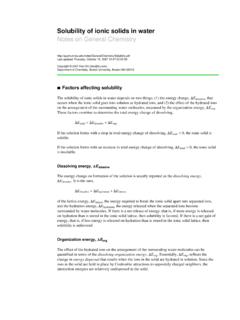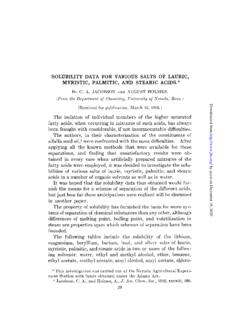Transcription of Solubility of KHT and Common ion Effect v010714
1 Solubility of KHT and Common ion Effect v010714 You are encouraged to carefully read the following sections in Tro (2nd ed.) to prepare for this experiment: Sec , pp 743-48 ( Solubility Equilibria and the Solubility Product Constant) Objectives: You will observe the Common ion Effect on the Ksp and molar Solubility of a slightly soluble salt , as determined from the hydrogen ion concentration. Background: Ksp: Ksp is the Solubility product constant for an ionic compound. Recall in Chapter 4 Section 5, a series of rules were given to determine whether an ionic compound was soluble or insoluble in water.
2 The Solubility product constant is the numerical value that explains the entries in the table. The larger the Ksp value the greater the degree of dissociation of the ionic compound in water. The Ksp of an ionic compound can be calculated using the equilibrium expression for the dissociation of that compound and the molar Solubility of the compound. The molar Solubility is the Solubility of the compound in moles per liter. Example: Dissociation of Silver Chloride AgCl (s) Ag+ (aq) + Cl- (aq) Ksp = [Ag+][Cl-] [Ag+] [Cl-] Initial 0 0 Change +x +x Equilibrium x x In the table, x = [Ag+] = [Cl-] = molar Solubility of AgCl, the concentration of dissolved AgCl in a saturated solution of this solid.
3 Since the Ksp for AgCl is x 10-10, then: Ksp = [Ag+][Cl-] = x 10-10 = (x)(x) x 10-10 = x2 x 10-5 M = x = molar Solubility of AgCl in pure water Common Ion Effect : The Common Ion Effect is observed when an ionic compound is dissolved in a solution that already contains one of the ions found in the salt . Since Ksp is a constant that depends on the temperature of the solution but not on the concentrations of the components in solution and following Le Ch tlier s Principle, then the presence of a Common ion causes the Solubility of the ionic compound to be lowered compared to that found in pure water.
4 Example: Dissociation of Silver Chloride in M NaCl NaCl is a very soluble salt and will dissociate completely into Na+(aq) and Cl-(aq). The concentration of each ion will be equal to M. The presence of the Cl-(aq) ion means, that when AgCl is added to a solution containing the NaCl, the initial concentration of the Cl- (aq) ion is M. AgCl (s) Ag+ (aq) + Cl- (aq) Ksp = [Ag+][Cl-] [Ag+] [Cl-] Initial 0 Change +y +y Equilibrium y + y In the table, y represents the molar Solubility (not in water) but now in M NaCl(aq). Additionally, Ksp for AgCl is still x 10-10 since it is a constant.
5 So: Ksp = [Ag+][Cl-] = x 10-10 = (y)( + y) x 10-10 = (y) + y2 Rearrangement: 0 = y2 + - x 10-10 Using the Quadratic Equation: x 10-9 = y = molar Solubility of AgCl in M NaCl Note that y, Solubility in NaCl(aq), is much lower than the Solubility in pure water (x from above) as predicted by LeChatelier s principle. In this laboratory, you will observe the Effect of the presence of a Common ion on the molar Solubility and Ksp of potassium hydrogen tartrate. KHT (s) dissociates into potassium ion, K+(aq), and hydrogen tartrate ion, HT- (aq) in solution. The HT- concentration can then be determined stoichiometrically by titrating it against the hydroxide ion, OH.
6 HT- (aq) + NaOH H2O (l) + NaT-(aq) Then by using an ICE chart along with the Solubility of KHT (which equals the concentration of HT-), Ksp can be calculated for KHT at the temperature for the experiment. KHT (s) K+(aq) + HT- (aq) Ksp = ??? Titration of a Saturated Potassium Hydrogen Tartrate (KHT) Solution Against Standardized NaOH Preparation of the Saturated KHT Solution for Titration 1. Gather: a. 3 125-mL Erlenmeyer flasks (washed and rinsed with and distilled water) b. 1 100-mL Graduated Cylinder (washed and rinsed with distilled water) c. 1 250-mL Beaker (washed and rinsed with distilled water) d.
7 1 Funnel (washed and dried) e. 1 25-mL Volumetric Pipet (washed) f. Pipet bulb g. Stirring Rod (washed and dried) h. 1 piece of Filter Paper i. 1 250-mL Erlenmeyer flask (washed and dried) 2. Mass g of KHT 3. Transfer the KHT into a clean 250-ml beaker 4. Using graduated cylinders add the volumes of NaCl and KCl indicated by your instructor to the KHT. 5. Stir the mixture with a stir rod for approximately 20 min Solution # Volume of M NaCl in mL Volume of M KCl in mL 1 2 3 4 5 6 7 8 9 10 11 6. Using a 250-Erlenmeyer flask, funnel, and filter paper, prepare a gravity filtration apparatus.
8 7. Filter your solution. (The filtrate must be clear) 8. Using a 25-ml volumetric pipet, withdraw 25-mL of KHT solution and discard. 9. Using the 25-mL volumetric pipet, transfer 25-ml of the saturated KHT solution into a 125-mL Erlenmeyer Flask and record on the data sheet as Volume of HT- to the mL. 10. Repeat 1 more times into an additional 125-mL flasks. 11. Measure the temperature of the two solutions and record the temperature on your data sheet. 12. Add two drops of phenolphthalein indicator to each of the saturated KHT solutions in the 125-mL Erlenmeyer flasks Preparation of the Standard NaOH Solution for Titration Remember standardized NaOH is valuable and time consuming to make.
9 Take only what you need from the bottle, and be certain the stock bottle is tightly sealed after you use it. 1. Rinse the buret with a small portion (~5 mL) of the NaOH solution, discard this rinse. 2. Fill the buret with NaOH and be certain no air bubbles exist in the tip of the buret. These will be blown out when the buret is full and the stopcock is opened. Discard this small bit of solution. Titration 3. Record the indicated molarity of the standardized NaOH solution from the bottle ( M) onto your data sheet. 4. Record the initial buret reading on your Data sheet to the nearest ml.
10 5. Titrate the solution with the standardized NaOH solution until the light pink end point persists for at least 30 s. 6. Record the final buret reading on your data sheet to the nearest ml. 7. Refill your buret with additional NaOH 8. Titrate a second sample of your filtrate. 9. Continue titrating samples until your instructor has approved 2 titrations. Data Run 1 Run 2 Volume of M KCl Volume of M NaCl Volume of KHT saturated solution titrated Temperature of KHT solution Molarity of standardized NaOH Initial Buret Reading of NaOH (mL) Final Buret Reading of NaOH (mL) Instructors initials Results Titration.

